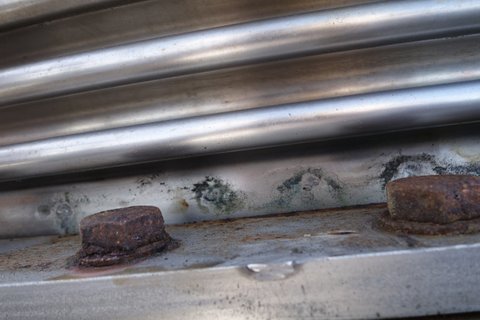KO...
NASA tested 321-A CRES in a marine environment and discovered a tendency for this kind of penetrating corrosion. I have also seen this peppered-pitting corrosion in acft ECS duct exterior surfaces [no bellows as-of-yet], but have NOT been able to determine the cause... especially when adjacent pieces of 321 sheet metal never seem to pit like these few/specific sheet metal sections.
NOTE.
Bellows formed from Inconel [nickel alloy] 600 or Inconel [nickel alloy] 625 would likely perform much better in this marine environment, especially with complimentary [similar material] fasteners.
NOTE.
Aerospace bellows often have an internal sleeve seam-welded on the up-stream end of the bellows intake, spanning most/all the convolutions up-to max extension, for fluid-flow stability. IE: the separated convolution roots tend to introduce high frequency turbulence in the duct flow that the long-sleeve minimizes/eliminates. IF this sleeve is oriented so flow is upward [sleeve is fixed on lower internal end of bellows], then even minor back-flow [condensation, carbon residues, etc] could easily be trapped/stagnated between the sleeve and convolutions. In this case a discrete pattern of 'large-enough' bleed holes, positioned just above the sleeve attachment, could be useful in flushing-out acidic-gas/fluids.
Regards, Wil Taylor
o Trust - But Verify!
o We believe to be true what we prefer to be true. [Unknown]
o For those who believe, no proof is required; for those who cannot believe, no proof is possible. [variation,Stuart Chase]
o Unfortunately, in science what You 'believe' is irrelevant. ["Orion", Homebuiltairplanes.com forum]

